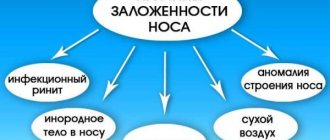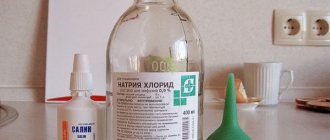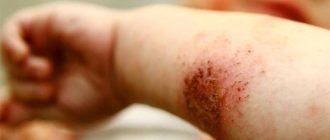What should parents do if their baby has a stuffy nose?
If your baby regularly has a stuffy nose, then there is no need to take risks and wait for complications to arise. If possible, it is better to immediately seek advice from your doctor. An experienced pediatrician will be able to correctly diagnose and prescribe adequate treatment. In case of an allergic reaction, the doctor will help not only identify the cause, but also select remedies to eliminate it.
Parents can independently check whether the child has dried crusts in his nose. You can clean your baby's nasal passages with rolled cotton wool soaked in saline or salted water. Liquid mucus can be sucked out with a small enema or using an aspirator. It is better not to use any nasal drops without your doctor's permission.
Pediatricians recommend ventilating, controlling the air humidity in the room, and rinsing the nose with a water-salt solution. If there is no humidifier, then you need to hang wet towels and place a basin or bucket of water near the radiator. It is better not to turn on air conditioners because they dry out the air.
Clean your nose with cotton swabs Remove excess liquid with an aspirator Humidify the air
How to identify the cause of a stuffy nose?
In order for the help of parents and doctors to be correct, it is necessary to determine why such a problem occurs. An infant may have a stuffy nose for the following reasons:
- Formation of mucous membrane. In the first 2-3 months after birth, newborn children become accustomed to our environment. At the same time, the nasal mucosa is also formed. During these changes in the body, swelling occurs, causing the appearance of clear mucus and the formation of crusts. Nasal congestion in newborns is considered normal and does not require treatment.
- ARVI. The main symptom of a viral infection is snot. They can be thick or liquid. If the mucus is liquid, then it flows out on its own, and the child, although with difficulty, can breathe. Thick snot completely blocks the nose, which causes discomfort. With ARVI, in addition to nasal congestion, there is a cough, fever and a red throat.
- Insufficient air humidity in the children's room. Children's mucous membranes react very sensitively to lack of moisture and begin to dry out. The resulting crusts prevent the child from breathing normally. This problem is especially relevant during the heating season.
- Overheat. The body of children in the first year of life is not yet able to regulate body temperature on its own. If the baby is dressed warmly, he overheats, experiences discomfort, and the nasal mucosa dries out. When overheated, the baby's body temperature rises, and the baby's skin becomes moist.
- Teething. During teething, swelling of the mucous membranes of the mouth and nose occurs. At this time, the child’s body’s immunity is reduced and is susceptible to infection. As a rule, all unpleasant symptoms from this cause disappear after the tooth appears.
- Allergy. Unfortunately, recently children are increasingly becoming allergic to household items. A child's body can be extremely sensitive to household chemicals, dust, plants and pet hair. The allergen can be identified independently by exclusion or using laboratory tests.
- Entry of a foreign body. A child may put a foreign object up his or her nose. Parents can notice and remove large things on their own, but small ones only by an ENT specialist. In this case, only one nostril does not breathe, and there are no signs of a cold. In the first days, the child only sneezes, and after a week of inactivity, purulent discharge appears.
- Pathology of the nasal cavity. Basically, the child’s mother learns about this reason already in the maternity hospital or during a routine examination by specialists.
Why does nasal congestion occur in infants?
You can get an answer to this question only if you learn about the structural features of a small nose that predispose it to congestion.
These features are that:
- Young children, unlike adults, have not three, but two nasal passages (the lower one is missing);
- Infants do not have developed paranasal (paranasal) sinuses;
- The nasal passages and the airway lumen in general are narrow;
- The nasolacrimal duct, located in the nasal cavity, is short and wide, with an imperfect valve apparatus, which causes inflammation of the eyes during a runny nose and vice versa;
- The mucosa is thin, vulnerable, rich in blood vessels, and therefore prone to rapid swelling and trauma;
- Mucus is produced in insufficient quantities, its physicochemical and protective properties are still imperfect.
All of the above predisposes to the fact that a runny nose and difficulty in nasal breathing are common occurrences in infants.
Causes of nasal congestion can be:
- Inflammatory process of infectious origin (usually as a result of viral infections);
- Allergic swelling due to allergenic particles entering the mucous membrane;
- Dry, warm, dusty air;
- Insufficient drinking regime;
- Individual structural features of the nasopharynx, tumor formations in this area.
Each reason leads to the fact that it is difficult for the baby to breathe through his nose. How to figure out what’s wrong and how to effectively help restore breathing.
How to safely treat a newborn baby?
Of course, if a newborn often has a stuffy nose, this problem cannot be ignored. However, you don't always need to worry. In the first month of life, a clogged nose is normal. During this period, the mucous membrane is still forming and adapting to work. A little clear mucous discharge is normal. Drug treatment is not required in this situation. To alleviate the child’s condition, you need to drip saline into the nose and regularly clean the nasal passages.
A reason for concern for parents should be a situation where a newborn’s nose is clogged for 7-10 days. Especially if at this time the appetite is reduced, weight loss occurs, and the child cries all the time. All of these symptoms may indicate a serious illness and require qualified medical care. Treatment should be carried out only with those drugs prescribed by the pediatrician.
How to treat a baby?
The tactics for treating a stuffy nose in a baby depends on the cause of the problem. If you have a runny nose of an allergic nature, it is necessary to protect your baby from allergens. If a foreign body gets in, try to remove it yourself, and if unsuccessful, consult a doctor. And if the swelling of the mucous membrane is caused by teething, then you just need to wait.
The situation is more serious when the cause of a stuffy nose is a viral or bacterial infection. In this case, to treat nasal congestion in a baby, you will need to use medications. Usually, if an infant has a stuffy nose, pediatricians prescribe specialized means for rinsing the nasal canals (Aquamaris, Aqualor, Physiomer, saline solution), and for some indications it is necessary to use vasoconstrictor drops (Snoop, Otrivin Baby, Galazolin).
Aqua Maris
Aqualor Baby
Otrivin Baby
To alleviate a child's condition when he has a cold, experts advise giving the baby water and regularly cleaning the nasal turbinates. The baby will be more comfortable if he has a small pillow or cushion under his head.
Medications
Modern pharmacology can offer a huge number of drugs for the common cold in infants. The following tools are used most often:
Let's look at the drugs in more detail.
Pinosol
Antiseptic, anti-inflammatory drug. It is used for a runny nose, upper respiratory tract infection, and inflammation of the nasal mucosa. Helps when a baby has thick snot. Active ingredients: essential oils of eucalyptus, pine, peppermint.
You can treat a runny nose in a child with Pinosol by instilling a drop or two several times a day. Side effects include burning. The medicine is contraindicated for babies younger than 6 months.
Derinat
Immunostimulant with antibacterial and antiviral effects. Restores the function of the nasal mucosa and promotes rapid healing of damage.
The active ingredient is sodium deoxyribonucleate. Used for rhinitis of infectious origin. Also in cases where the nasal mucosa is irritated or damaged. Treats inflammatory processes in the nasal and oral cavity.
To cure rhinitis, a one-year-old child needs to drop 2 drops into each nostril several times a day. Approved for use even by newborns. You can instill 1 drop, or 2 drops for complex forms of the disease. Side effects may result in a slight burning sensation. The use of the drug is contraindicated in case of an individual negative reaction of the child’s body to such drugs or their components.
Salin
An effective remedy for a runny nose in infants. The active element is sodium chlorine. The medicine effectively relieves swelling, thins thick snot, and softens the dry crust that has formed. Used for rhinitis of various etiologies. After nose surgery. In combination with vasodilator drugs, Salin prevents the child’s body from getting used to the drugs and enhances their effect. Available in the form of spray and drops.
It is better to treat snot in an infant with Salin drops. Instillation should be done several times a day, 1 or 2 drops, depending on the severity of the disease.
There is no information about the side effects of this remedy for the common cold in infants. Salin is contraindicated in severe pathologies such as hypokalemia, pulmonary or cerebral edema, renal or heart failure.
Nazivin
Vasoconstrictor. The main component is oxymetazoline. Relieves swelling of both the nasal mucosa and paranasal sinuses. This makes breathing easier.
The body of infants does not get used to the drug. It does not accumulate in the blood. Used for sinusitis, rhinitis, inflammation of the middle ear and eustachian tube. Also various diseases that lead to difficulty breathing.
You can cure a runny nose in a baby by instilling the medicine 2 or 3 times a day, 1 drop into each nasal cavity. Not only instillation, but also application of the drug on cotton wool and periodic lubrication of the nasal mucosa will help overcome nasal congestion.
Side effects of the drug include excessive dryness in the nose and burning. With long-term use, more serious consequences are possible. For example, tachycardia, nausea, headache. It is contraindicated to use Nazivin for:
- atrophic rhinitis;
- angle-closure glaucoma;
- allergic reaction.
When you purchase a Nazivin baby, look at the percentage. Take a solution of no more than 0.01%. Use strictly as recommended by your doctor.
Aqualor baby
Moisturizing and restoring the normal functioning of the nasal mucosa, the drug. Has a slight antimicrobial effect. The active element is sea water, enriched with essential microelements. It has a gentle effect on the nasal cavity, due to the absence of synthetic preservatives in the composition.
Caution in treatment - what not to do
Any treatment must be safe, especially if we are talking about a small child. In their desire to help, some parents are not afraid to use dubious means or use drugs without taking into account the age of the baby. Using comprehensive treatment methods is good, but the main thing is to do no harm. When treating a stuffy nose in children of the first year of life, you should not:
- Use drops from garlic, onion, eucalyptus, beetroot, etc.
- Take antibacterial and hormonal medications without a pediatrician’s recommendation.
- When preparing your own nasal rinsing solution, you should not neglect the proportions of the ingredients. An incorrect ratio of components can damage the mucous membrane.
- Use vasoconstrictor drops for more than 3 days.
- Put breast milk in your nose. It provokes the proliferation of bacteria.
Prevention
A stuffy nose in an infant causes not only concern for parents, but also discomfort for the baby. It is advisable to try to avoid this phenomenon so that you do not have to use medications in the future.
For prevention, try to follow these rules:
- regularly carry out wet cleaning and ventilate the children's room;
- walk outdoors every day;
- do not allow your child to communicate with sick people;
- In autumn and winter, rinse your child’s nose with a water-salt solution after a walk.
When is the best time to see a doctor right away?
Parents are not always able to adequately assess the child’s condition from a medical point of view and determine how to treat the baby. In some cases, if you have nasal congestion, it is better to visit your doctor as soon as possible.
So, we run to the doctor if:
- the child cannot eat normally and loses weight;
- the baby does not sleep well and cries all the time;
- parents observe suffocating attacks;
- the baby has a constantly stuffy nose for 7 days;
- purulent discharge is observed;
- there are signs of a bacterial or viral infection (red throat, fever, runny nose, lethargy).
The main drugs that help treat a runny nose in infants
A runny nose in newborns does not cause much concern. The small organism gets used to the surrounding world and environment. Often, it is during the postpartum period that a baby develops moist discharge in the nose - this is normal. It’s another matter when a child’s snot interferes with sleeping and eating normally. What to do in this situation? How and with what to treat a runny nose in a baby?











